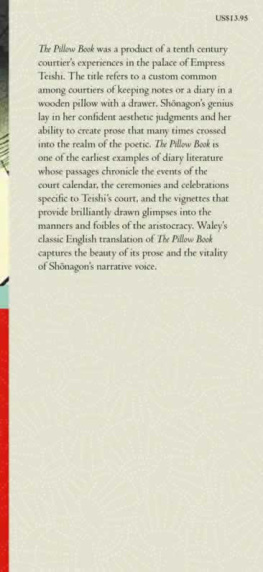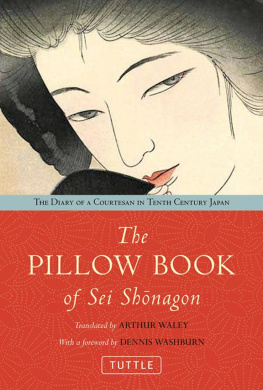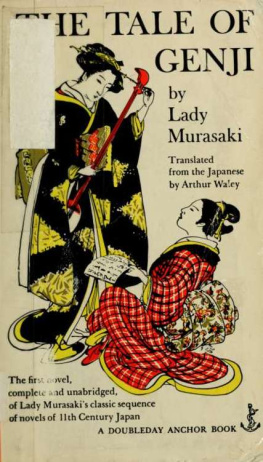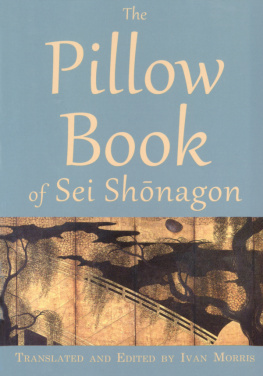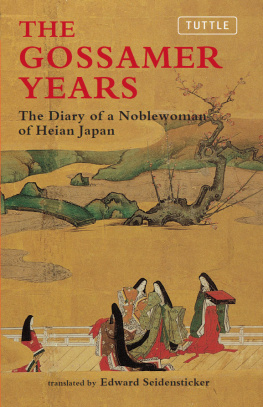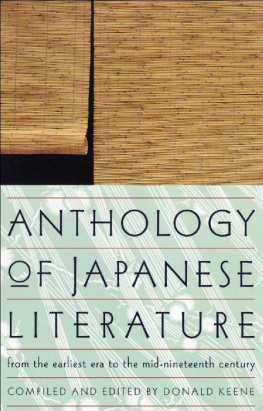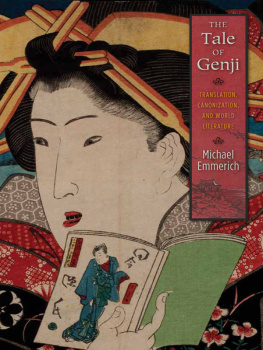Sei Shonagon - The Pillow Book
Here you can read online Sei Shonagon - The Pillow Book full text of the book (entire story) in english for free. Download pdf and epub, get meaning, cover and reviews about this ebook. year: 2006, publisher: Penguin, genre: Art. Description of the work, (preface) as well as reviews are available. Best literature library LitArk.com created for fans of good reading and offers a wide selection of genres:
Romance novel
Science fiction
Adventure
Detective
Science
History
Home and family
Prose
Art
Politics
Computer
Non-fiction
Religion
Business
Children
Humor
Choose a favorite category and find really read worthwhile books. Enjoy immersion in the world of imagination, feel the emotions of the characters or learn something new for yourself, make an fascinating discovery.
- Book:The Pillow Book
- Author:
- Publisher:Penguin
- Genre:
- Year:2006
- Rating:4 / 5
- Favourites:Add to favourites
- Your mark:
- 80
- 1
- 2
- 3
- 4
- 5
The Pillow Book: summary, description and annotation
We offer to read an annotation, description, summary or preface (depends on what the author of the book "The Pillow Book" wrote himself). If you haven't found the necessary information about the book — write in the comments, we will try to find it.
The Pillow Book — read online for free the complete book (whole text) full work
Below is the text of the book, divided by pages. System saving the place of the last page read, allows you to conveniently read the book "The Pillow Book" online for free, without having to search again every time where you left off. Put a bookmark, and you can go to the page where you finished reading at any time.
Font size:
Interval:
Bookmark:


THE PILLOW BOOK
SEI SHNAGON (?966?1017) was a gentlewoman in the court of Empress Teishi, in what is now Kyoto, Japan. The Pillow Book is her journal of anecdotes and observations based on her life at court. It was probably completed in the first years of the eleventh century.
MEREDITH MCKINNEY gained a Ph.D. in medieval Japanese literature from the Australian National University in Canberra, where she presently teaches in the Japan Centre. She lived and taught in Japan for twenty years, and now lives near Braidwood, New South Wales. Her other published translations include Ravine and Other Stories by Furui Yoshikichi (1997) and The Tale of Saigy (1998).
SEI SHNAGON
Translated with Notes by MEREDITH MCKINNEY
PENGUIN BOOKS
PENGUIN BOOKS
Published by the Penguin Group
Penguin Books Ltd, 80 Strand, London WC2R 0RL, England
Penguin Group (USA) Inc., 375 Hudson Street, New York, New York 10014, USA
Penguin Group (Canada), 90 Eglinton Avenue East, Suite 700, Toronto, Ontario, Canada M4P 2Y3
(a division of Pearson Penguin Canada Inc.)
Penguin Ireland, 25 St Stephens Green, Dublin 2, Ireland (a division of Penguin Books Ltd)
Penguin Group (Australia), 250 Camberwell Road, Camberwell, Victoria 3124, Australia
(a division of Pearson Australia Group Pty Ltd)
Penguin Books India Pvt Ltd, 11 Community Centre, Panchsheel Park, New Delhi 110 017, India
Penguin Group (NZ), cnr Airborne and Rosedale Roads, Albany, Auckland 1310,
New Zealand (a division of Pearson New Zealand Ltd)
Penguin Books (South Africa) (Pty) Ltd, 24 Sturdee Avenue,
Rosebank, Johannesburg 2196, South Africa
Penguin Books Ltd, Registered Offices: 80 Strand, London WC2R 0RL, England
www.penguin.com
This translation first published in Penguin Classics 2006
1
Copyright Meredith McKinney, 2006
All rights reserved
The moral right of the translator has been asserted
Except in the United States of America, this book is sold subject
to the condition that it shall not, by way of trade or otherwise, be lent,
re-sold, hired out, or otherwise circulated without the publishers
prior consent in any form of binding or cover other than that in
which it is published and without a similar condition including this
condition being imposed on the subsequent purchaser
EISBN : 9780141906942
I would first like to thank The Australian National Universitys Japan Centre, where I was able to work on this translation as a Visiting Fellow from 2002 to 2005. I also wish to thank the Australian Governments Asialink programme, which enabled me to spend three precious months in Japan during 2005 while I completed the translation.
Friends have been invaluable to me throughout this time, both in their warm support and in their immensely helpful reading and comments on some or all of the translation at various stages. I am particularly grateful to dear friends Timoshenko Aslanides, Nicola Bowery, Julian Davies, David Farrah, Stephanie LHeureux and Simon Patton, as well as to Naomi Fukumori for her long-distance professional help and comments.
I also owe a deep debt of gratitude to Royall and Susan Tyler, who have helped and supported me in countless ways throughout this undertaking, and most particularly to Susan, whose meticulous and deeply informed editorial assistance has been of immense value to me.
My gratitude to Sugai Minoru for his illustrations, taken from details found in various early scrolls, and to Shgakukan Publishing Company for making them available.
Finally, I would like to thank Penguin Classics editor Lindeth Vasey for her wonderfully friendly and sensitive editorial assistance throughout this project.
Japanese order, family name first.
966? Sei Shnagon born. Father Kiyohara Motosuke, mothers name unknown.
Emperor Murakami, Ichijs grandfather, dies. Interregnum for two years.
Eny(b. 959), Ichijs father, succeeds to the throne.
Princess Senshi (9641035) becomes Kamo High Priestess (until 1031).
Fujiwara Teishi born. Father Fujiwara Michitaka (b. 953), mother Takashina Kishi (d. 996).
Fujiwara Senshi (9621001), daughter of Fujiwara Kaneie, becomes Empress of Emperor Eny.
Ichij born. Father Emperor Eny, mother Fujiwara Senshi.
Emperor Eny retires and takes Buddhist orders. Succeeded by Kazan (9681008), eldest son of Emperor Reizei.
Emperor Kazan retires and takes Buddhist orders. Succeeded by Ichij.
Teishi becomes High Consort to Emperor Ichij. Fujiwara Kaneie, Michitakas father, becomes Chancellor.
Retired Emperor Eny dies; Empress Dowager, Fujiwara Senshi, takes the tonsure.
Fujiwara Michitaka becomes Chancellor. ? Sei Shnagon becomes a gentlewoman in Teishis court.
994? Fujiwara Korechika (9741010), Michitakas son, presents Empress Teishi with the paper Sei Shnagon will use for her Pillow Book.
Chancellor Fujiwara Michitaka dies. Michitakas brother and rival, Fujiwara Michinaga (9661027), increases his power.
Teishis brothers Korechika and Takaie (9791044) attack Retired Emperor Kazan; they are arrested and forced to leave the capital. ? Governor of Ise Minamoto Tsunefusa visits Sei Shnagon and discovers and circulates the early draft of The Pillow Book. Teishi gives birth to a daughter, Princess Shshi.
Korechika and Takaie are allowed to return to the capital.
Major fire at Imperial Palace. Teishi gives birth to a son, Prince Atsuyasu.
1000 Michinagas daughter Shshi becomes High Consort to Emperor Ichij, replacing Teishi in his favour. Teishi gives birth to a daughter, Princess Kyshi, and dies two days later. Sei Shnagon leaves the court.
1011 Emperor Ichij dies. Succeeded by Sanj.
1017 Last reference to Sei Shnagon.
A thousand years ago, in a world in many ways unimaginably different from ours, a lady at the imperial court of Japan settled herself in front of a precious bundle of paper and began to write the extraordinary work later called Makura no sshi, known to English readers as The Pillow Book. In it she wrote about her world, in a voice so vividly alive that we find ourselves in the presence of a woman we recognize as we would a friend.
The world Sei Shnagon lived in and wrote for was the intimate world of the court instantly recognizable to her and her audience, but so opaque to us that often we have only her words to guide us. As we read her apparently crazy quilt of vignettes and opinions and anecdotes, we find ourselves deep inside this world, and feel her responses along our own nerves. But the modern readers compelling sense of intimacy with Sei Shnagon and her world, which is one of the great achievements of her writing, is of course based on an illusion. We do not know that world, and before we enter it with her it is best to learn a little about it.
TO HER WORLD
Sei Shnagon lived at the height of the Heian period. Heian roughly translates as peace and tranquility, and nicely expresses the nature of this long, sunny period in Japanese history, stretching from 794 to 1186, when Japanese culture flowered and came into its own. This flowering grew from the fertilizing contact of the native culture with that of China, but by Sei Shnagons time the direct impact of that powerful foreign civilization had largely been absorbed and contact with China had virtually ceased, although its culture was still a potent presence in civilized Japanese life.
Font size:
Interval:
Bookmark:
Similar books «The Pillow Book»
Look at similar books to The Pillow Book. We have selected literature similar in name and meaning in the hope of providing readers with more options to find new, interesting, not yet read works.
Discussion, reviews of the book The Pillow Book and just readers' own opinions. Leave your comments, write what you think about the work, its meaning or the main characters. Specify what exactly you liked and what you didn't like, and why you think so.


